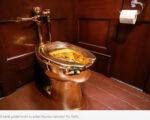Watch: How RAAC concrete can crumble under pressure
With just days to go before the start of the new school year, more than 100 schools in England have been told to shut buildings made with a certain type of concrete unless they put in place safety measures.
Here is what we know so far about the material at the centre of all this.
What is RAAC?
Reinforced autoclaved aerated concrete (RAAC) is a lightweight material that was used in roofs, floors and walls between the 1950s and 1990s, mostly on one and two-storey buildings.
It is a cheaper alternative to standard concrete. It is quicker to produce, and easier to install.
It is aerated, or “bubbly”, like an Aero chocolate bar.
But it is less durable and has a limited lifespan of around 30 years.
Its structural behaviour differs significantly from traditional reinforced concrete.
Moreover, it is susceptible to structural failure when exposed to moisture. The bubbles can allow water to enter the material.
If that happens, any rebar reinforcing RAAC can also decay, rust and weaken.
Because of this, RAAC is often coated with another material, such as bitumen on roofing panels. But this material can also degrade.
The Standing Committee on Structural Safety (SCOSS) noted that: “Although called ‘concrete’, RAAC is very different from traditional concrete and, because of the way in which it was made, much weaker.”
According to Loughborough University, there are tens of thousands of these structural panels already in use and “many are showing signs of wear and tear and deterioration”.
The Health and Safety Executive says RAAC is now beyond its lifespan and may “collapse with little or no notice”.
Graphic explaining What is RAAC concrete?
When were these risks first identified?
The differences to traditional concrete – and the risks of RAAC use – were first outlined as far back as 1961, around the time when Britain first began to use the material.
The Institution for Structural Engineers said in a report, seen by the BBC’s Newsnight, that RAAC was so different to traditional concrete that “it is perhaps unfortunate that the term concrete has been retained for these aerated products”.
The report found that short-term exposure to moisture reduced strength by about 13%, while long-term exposure to “polluted air” reduced it by 40%.
The potential safety issues of ageing RAAC were first reported in the 1980s and 1990s, when roof collapses led to buildings being demolished.
A 1996 government-funded report by the Building Research Establishment had found RAAC panels cracking in a housing development, and cracks and bends in panels installed in schools.
It said that while there were no immediate safety risks, any RAAC panels in visually poor condition should be inspected every year.
It recommended inspections every five years for those in good condition.
A report by the same body in 2002 came to three new conclusions:
1. Material used to coat RAAC will have very likely become compromised in panels over 20 years old.
2. Crucially, that corrosion can occur without visual indication that the panel was in poor condition – ie, there was a the risk of collapse without warning in panels over 20 years old.
3. Some panels did not meet regulations when they were installed, and were inadequate to begin with.
What has been done to mitigate the risks?
The government has known since 1994 that some public sector buildings contain potentially compromised RAAC – and has been monitoring their condition since 2018.
Professor Chris Goodier from Loughborough University, who has studied the problem for the NHS, said: “We have a very old building stock in this country right back to the Victorian era and industrial revolution. RAAC is one of many materials that hasn’t been looked properly over the decade.”
This is a particular problem for schools which sometimes have just one building manager, untrained in structural engineering.
New guidance was issued in 2021 and 2022 about how to manage RAAC, and the DfE sent out a questionnaire last year to “all responsible bodies”, asking them to provide information about the use of RAAC in schools across the country.
Schools Minister Nick Gibb said the expert advice had been that if RAAC was not in a critical condition, it was safe to continue to use the building.
But over the summer a RAAC beam that had previously been considered low risk collapsed, he said.
That led to those schools identified with RAAC now all being labelled potentially dangerous – and closed or partially closed at short notice.
Are you a teacher at an affected school? Is your child’s school impacted? Share your experiences by emailing haveyoursay@bbc.co.uk.
Please include a contact number if you are willing to speak to a BBC journalist. You can also get in touch in the following ways:
If you are reading this page and can’t see the form you will need to visit the mobile version of the BBC website to submit your question or comment or you can email us at HaveYourSay@bbc.co.uk. Please include your name, age and location with any submission.









